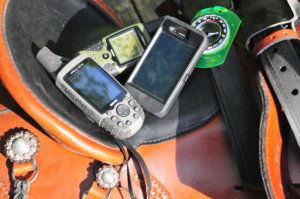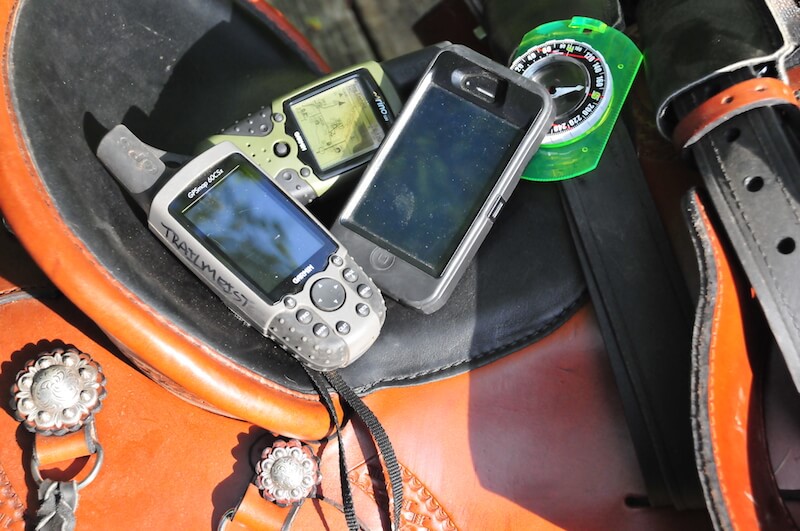Modern Ways to Stay Connected on the Trail
by Robert Eversole
When is the last time you saw a telephone booth? The cell phones in everyone’s pocket are filling the desire for people to be constantly connected. Whether you’re for or against them, high tech electronics have become ubiquitous in the 21st century world that we live in.
Global Positioning System
The electronic devices that impact trail riders more than any other are primarily centered around Global Positioning System—GPS—related items. These high tech tools can be valuable for complementing your solid understanding of how to use a tried and true traditional map and compass. GPS’s all use signals sent from a constellation of manmade satellites constantly orbiting overhead, no need for cell phone towers here. The same signals and similar technology are used whether the device is a hand held GPS that leaves electronic bread crumbs back to the trailhead, or one that signals a helicopter rescue mission in a wilderness area. For some riders, using a GPS for navigation is part of the fun associated with trail riding. Others may simply want a backup for paper topographic maps, a little insurance that they can find their way back home.

There are a wide variety of GPS units on the market from various manufacturers. GPS units best suited for trail riding are small, hand held, rugged receivers used for pinpointing specific locations on trails and in the back country. However, there are a few features that you should look for in a unit.
- Sensitivity – GPS units must be able to receive a satellite signal to work. Devices that pair an external or quad helix antenna with a high-sensitivity processor chip will be the most accurate and sensitive. That means the receivers can more often pick up a signal in a deep canyon or through a dense tree canopy.
- Long battery life – Unless you enjoy looking at a blank screen, look at how long a fresh set of batteries will last and bring spares.
- Features – Color screens, altimeters, and even cameras are options that are available on newer units. Keep in mind that the more features a GPS has the faster the batteries will be depleted and the lighter your wallet will be after the purchase.
Smart Phone Applications
A new, and lower cost, entry into the world of GPS equipment are applications that riders can download into their mobile phones. There are apps available for all major smart phones that use GPS information to turn it into a capable backcountry navigation tool. I use an application called ViewRanger that allows me to download topographic maps to my cell phone and then plots my course when I’m in the backcountry. With these powerful new tools, you can plan, follow and record routes and create waypoints all without cell tower reception. With a very low price point, compared to a traditional GPS, these programs offer an easy entry into the world of GPS’s.
For Emergencies(Mostly)
For riders whose idea of getting away from it all means going far beyond the range of cell towers there are two main devices to consider. The SPOT and InReach systems both offer an electronic safety net by which riders can send a signal to a satellite to alert EMS organizations of an emergency. Both of these devices utilize a compact unit that can send a signal to a satellite that then sends the signal back to a location on earth where the message can be routed to emergency service providers. Both the SPOT and InReach require a subscription in addition to the purchase of the unit itself. Also, both devices now offer users the ability to send short text messages to family and friends to let them know that you’re making memories to last a life time and they’re stuck in civilization. The InReach expands on this technology and allows family and friends to send you text messages as well (perhaps to say that you’re urgently needed at home).
Although we’ve looked at three different types of high tech gear that can aid you in your trail rides, please remember that the very best, and most sophisticated, technology is YOU. Stay alert and attentive, learn how to use a map and compass, be prepared, and ride. For more information on this and other trail riding topics visit www.TrailMeister.com.
Published July 2018 Issue

Robert Eversole, ”the trail meister,” owns www.TrailMeister.com, the largest database of horse riding and camping areas in the U.S. with free trail and trailhead information, trail maps, and much more to help horse enthusiasts experience the joys of trail riding. Robert is a registered riding instructor with PATH International, a mounted search and rescue team member, and a U.S. Marine who has served on the board of the Backcountry Horsemen of Washington (BCHW). He is enjoying his new career helping fellow trail riders stay found and safe on the trail. When not on the trail, The Trail Meister resides near Spokane, WA and teaches land navigation to a wide variety of outdoor groups across the nation. For North America’s largest horse trail and camping directory, trail tips, and more, visit www.TrailMeister.com.






